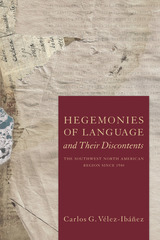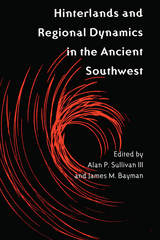215 books about Southwest, New and 3
start with H
215 books about Southwest, New and 3
215 books about Southwest, New
3 start with H start with H
3 start with H start with H

Hand Trembling, Frenzy Witchcraft, and Moth Madness
A Study of Navajo Seizure Disorders
Jerrold E. Levy
University of Arizona Press, 1987
According to traditional Navajo belief, seizures are the result of sibling incest, sexual witchcraft, or possession by a supernatural spirit—associations that have kept such disorders from being known outside Navajo families. This new study is concerned with discovering why the Navajos have accorded seizures such importance and determining their meaning in the larger context of Navajo culture. The book is based on a 14-year study of some 40 Navajo patients and on an epidemiological survey among the Navajos and among three Pueblo tribes.
[more]

Hegemonies of Language and Their Discontents
The Southwest North American Region Since 1540
Carlos G. Vélez-Ibáñez
University of Arizona Press, 2017
Spanish and English have fought a centuries-long battle for linguistic dominance in the Southwest North American Region. Covering the time period of 1540 to the present, Hegemonies of Language and Their Discontents provides a deep and broad understanding of the contradictory methods of establishing language supremacy in this U.S.-Mexico transborder region and the manner in which those affected have responded and acted, often in dissatisfaction and at times with inventive adaptations.
Well-regarded author Carlos G. Vélez-Ibáñez details the linguistic and cultural processes used by penetrating imperial and national states. He argues that these impositions have been not linear but hydra-headed, complex and contradictory, sometimes accommodated and sometimes forcefully imposed. Such impositions have created discontent resulting in physical and linguistic revolts, translanguage versions, and multilayered capacities of use and misuse of imposed languages—even the invention of community-created trilingual dictionaries.
Vélez-Ibáñez gives particular attention to both sides of the border, explaining the consequences of the fragile splitting of the area through geopolitical border formation. He illustrates the many ways those discontents have manifested in linguistic, cultural, educational, political, and legal forms.
From revolt to revitalization, from silent objection to expressive defiance, people in the Southwest North American Region have developed arcs of discontent from the Spanish colonial period to the present. These narratives are supported by multiple sources, including original Spanish colonial documents and new and original ethnographic studies of performance rituals like the matachines of New Mexico. This unique work discusses the most recent neurobiological studies of bilingualism and their implications for cognitive development and language as it spans multiple disciplines. Finally, it provides the most important models for dual language development and their integration to the "Funds of Knowledge" concept as creative contemporary discontents with monolingual approaches.
Well-regarded author Carlos G. Vélez-Ibáñez details the linguistic and cultural processes used by penetrating imperial and national states. He argues that these impositions have been not linear but hydra-headed, complex and contradictory, sometimes accommodated and sometimes forcefully imposed. Such impositions have created discontent resulting in physical and linguistic revolts, translanguage versions, and multilayered capacities of use and misuse of imposed languages—even the invention of community-created trilingual dictionaries.
Vélez-Ibáñez gives particular attention to both sides of the border, explaining the consequences of the fragile splitting of the area through geopolitical border formation. He illustrates the many ways those discontents have manifested in linguistic, cultural, educational, political, and legal forms.
From revolt to revitalization, from silent objection to expressive defiance, people in the Southwest North American Region have developed arcs of discontent from the Spanish colonial period to the present. These narratives are supported by multiple sources, including original Spanish colonial documents and new and original ethnographic studies of performance rituals like the matachines of New Mexico. This unique work discusses the most recent neurobiological studies of bilingualism and their implications for cognitive development and language as it spans multiple disciplines. Finally, it provides the most important models for dual language development and their integration to the "Funds of Knowledge" concept as creative contemporary discontents with monolingual approaches.
[more]

Hinterlands and Regional Dynamics in the Ancient Southwest
Alan P. Sullivan
University of Arizona Press, 2007
Hinterlands and Regional Dynamics in the Ancient Southwest is the first volume dedicated to understanding the nature of and changes in regional social autonomy, political hegemony, and organizational complexity across the entire prehistoric American Southwest. With geographic coverage extending from the Great Plains to the Colorado River, and from Mesa Verde to the international border, the volume’s ten case studies synthesize research that enhances our understanding of the ancient Southwest’s highly variable demographic, land use, and economic histories. For this volume, “hinterlands” are those areas whose archaeological records do not disclose the ceramic, architectural, and network evidence that initially led to the establishment of the Hohokam, Chaco, and Casas Grandes regional systems. Employing a variety of perspectives, such as the cultural landscapes approach, heterarchy, and the common-pool resource model, as well as technical methods, such as petrographic and stylistic-attribute analyses, the volume’s contributors explore variation in hinterland identities, subsistence ecology, and sociopolitical organization as regional systems expanded and contracted between the 9th and 14th centuries AD. The hinterlands of the prehistoric Southwest were home to a substantial number of people and were often used as resource catchments by the inhabitants of regional systems. Importantly, hinterlands also influenced developments of nearby regional systems, under whose footprint they managed to retain considerable autonomy. By considering the dynamics between hinterlands and regional systems, the volume reveals unappreciated aspects of the ancient Southwest’s peoples and their lives, thereby deepening our awareness of the region’s rich and complicated cultural past.
[more]
READERS
Browse our collection.
PUBLISHERS
See BiblioVault's publisher services.
STUDENT SERVICES
Files for college accessibility offices.
UChicago Accessibility Resources
home | accessibility | search | about | contact us
BiblioVault ® 2001 - 2024
The University of Chicago Press









